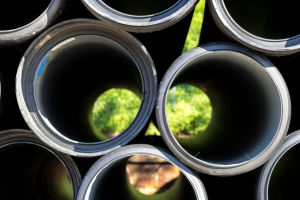 Sewer pipe bursting looks a little bit like magic if you compare it to the traditional methods of sewer replacement. With the use of underground construction equipment, including directional boring equipment, sewer technicians are able to pull a new pipe through the old pipe without digging a hole into the top surface of the ground. The sewer pipe bursting method is the perfect pipe replacement solution for a variety pipes including: asbestos, clay, cement, concrete, pitch fibre, and steel. This trenchless method can be used in pipes with a diameter as small as 75mm and as large as 300mm. The method works for pipe replacement as long as 100m. The most current methods allow installation in a single continuous length or short sections.
Sewer pipe bursting looks a little bit like magic if you compare it to the traditional methods of sewer replacement. With the use of underground construction equipment, including directional boring equipment, sewer technicians are able to pull a new pipe through the old pipe without digging a hole into the top surface of the ground. The sewer pipe bursting method is the perfect pipe replacement solution for a variety pipes including: asbestos, clay, cement, concrete, pitch fibre, and steel. This trenchless method can be used in pipes with a diameter as small as 75mm and as large as 300mm. The method works for pipe replacement as long as 100m. The most current methods allow installation in a single continuous length or short sections.
Pipe bursting is one type of trenchless sewer line replacement where an existing pipe is broken at the same time a new pipe of the same or larger diameter is pulled through to replace the existing pipe.
The following pieces of equipment are used for the sewer pipe bursting process:
- Expander head
- Hydraulic power pack
- Pulling machine
- Pulling rods
- Retaining device
A mechanically applied force is provided by an expander head bursting tool which splits or creates a brittle fracture of the initial pipe as the replacement pipe is pulled through at the same time. The new pipe can be of the same or larger diameter as the existing pipe.
The back end of the expander head is connected to the new pipe. The front end is connected to a cable or pulling rod. The new pipe and bursting head are launched from the insertion pit, and the pulling rod is pulled from the receiving pit by the pulling machine. The power source, which forces the bursting tool forward to break the existing pipe, comes from the pulling cable or rods, hydraulic power pack to the head, or pneumatic power to the head. The power source depends upon the bursting system design. This energy power is converted to a fracturing force on the existing pipe, breaking it and temporarily expanding the diameter of the cavity. The bursting head is pulled through the retaining device and pipe debris during the expansion. The process creates a temporary cavity, so the new pipe can be pulled through from the insertion pit.
This method has been used commercially for many years. City sewer work, which has complete access to the end of the line connections, has long been effective with this trenchless [sewer pipe bursting][1] method. As technologies have improved and become more readily available, these trenchless methods have moved into residential jobs as well.
Whether they are used in a residential or commercial environment, the advantages of trenchless sewer repair options are the same:
- Less disturbance to traffic. For a city project, this can be substantial if the repair that is needed is beneath a major street or highway. For a residential job this simply avoids disrupting sidewalk or driveway traffic.
- Shorter time for replacement. For commercial businesses, these trenchless methods can sometimes be completed over a weekend when the company may already be closed. In a residential setting, the shorter time means an abbreviated disruption to the daily routine at your home.
- Less environmental disturbance. In traditional sewer repair the atmosphere can be filled with debris and particles from the excavation process, a somewhat dangerous prospect for both commercial and residential settings.
- Reduced surface replacement expenses. This includes everything from pavement to sidewalks, yards to landscaping, and decking to fencing.
All of these advantages create both direct and indirect cost savings which can help offset the more expensive fees for trenchless sewer repair over traditional repair method costs. Pipe bursting and other trenchless sewer methods entered the residential market some 10 to 15 years ago. In spite of its availability, 78% of Angie’s List respondents say they have never heard of this “no dig” sewer repair option.
Once explained, many homeowners understand its advantages and select trenchless sewer repair over traditional sewer repair options. Understanding the available options helps home owners make a more well thought out decision. If, however, decisions are made in an emergency situation when a major sewer problem occurs, it is less likely that the decision made will be an informed one. [1]:


